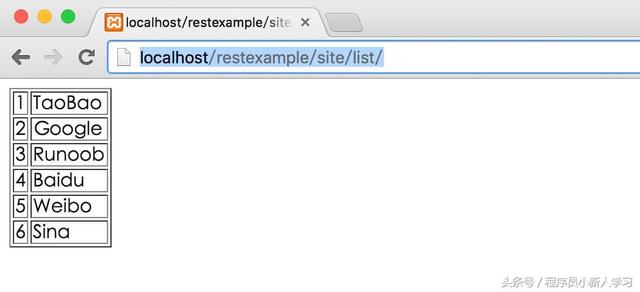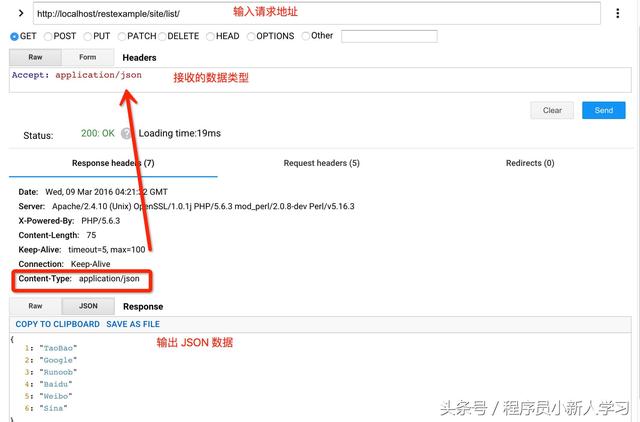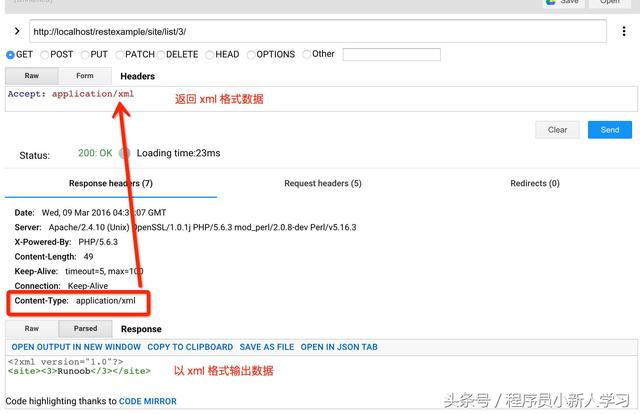PHP編程 RESTful
《PHP編程 RESTful》要點:
本文介紹了PHP編程 RESTful,希望對您有用。如果有疑問,可以聯系我們。
歡迎參與《PHP編程 RESTful》討論,分享您的想法,維易PHP學院為您提供專業教程。
REST(英文:Representational State Transfer,簡稱REST) ,指的是一組架構約束條件和原則.
符合REST設計風格的Web API稱為RESTful API.它從以下三個方面資源進行定義:
直觀簡短的資源地址:URI,比如:
http://example.com/resources/.傳輸的資源:Web服務接受與返回的互聯網媒體類型,比如:JSON,XML,YAM等.
對資源的操作:Web服務在該資源上所支持的一系列哀求方法(比如:POST,GET,PUT或DELETE).
本教程我們將使用 PHP(不用框架) 來創建一個 RESTful web service,在文章末尾你可以下載本章節使用到的代碼.
通過本教程你將學習到以下內容:
創建一個 RESTful Webservice.
使用原生 PHP, 不依賴任何框架.
URI 模式需要遵循 REST 規則.
RESTful service 接受與返回的格式可以是 JSON, XML等.
根據不同情況響應對應的 HTTP 狀態碼.
演示哀求頭的使用.
使用 REST 客戶端來測試 RESTful web service.
RESTful Webservice 實例
以下代碼是 RESTful 服務類 Site.php:
實例
<?php/* * 菜鳥教程 RESTful 演示實例 * RESTful 服務類 */ClassSite{private$sites = array(1 => 'TaoBao', 2 => 'Google', 3 => 'Runoob', 4 => 'Baidu', 5 => 'Weibo', 6 => 'Sina'); publicfunctiongetAllSite(){return$this->sites; }publicfunctiongetSite($id){$site = array($id => ($this->sites[$id]) ? $this->sites[$id] : $this->sites[1]); return$site; }}?>
RESTful Services URI 映射
RESTful Services URI 應該設置為一個直觀簡短的資源地址.Apache 服務器的 .htaccess 應設置好對應的 Rewrite 規則.
本實例我們將使用兩個 URI 規則:
1、獲取所有站點列表:
http://localhost/restexample/site/list/
2、使用 id 獲取指定的站點,以下 URI 為獲取 id 為 3 的站點:
http://localhost/restexample/site/list/3/
項目的 .htaccess 文件配置規則如下所示:
# 開啟 rewrite 功能Options +FollowSymlinksRewriteEngine on# 重寫規則RewriteRule ^site/list/$ RestController.php?view=all [nc,qsa]RewriteRule ^site/list/([0-9]+)/$ RestController.php?view=single&id=$1 [nc,qsa]
RESTful Web Service 控制器
在 .htaccess 文件中,我們通過設置參數 'view' 來獲取 RestController.php 文件中對應的哀求,通過獲取 'view' 不同的參數來分發到不同的方法上.RestController.php 文件代碼如下:
實例
<?phprequire_once("SiteRestHandler.php"); $view = "";if(isset($_GET["view"]))$view = $_GET["view"];/* * RESTful service 控制器 * URL 映射*/switch($view){case"all": // 處理 REST Url /site/list/$siteRestHandler = newSiteRestHandler(); $siteRestHandler->getAllSites(); break; case"single": // 處理 REST Url /site/show/<id>/$siteRestHandler = newSiteRestHandler(); $siteRestHandler->getSite($_GET["id"]); break; case"" : //404 - not found;break;}?>
簡單的 RESTful 基礎類
以下提供了 RESTful 的一個基類,用于處理響應哀求的 HTTP 狀態碼,SimpleRest.php 文件代碼如下:
實例
<?php/* * 一個簡單的 RESTful web services 基類 * 我們可以基于這個類來擴展需求*/classSimpleRest{private$httpVersion = "HTTP/1.1"; publicfunctionsetHttpHeaders($contentType, $statusCode){$statusMessage = $this -> getHttpStatusMessage($statusCode); header($this->httpVersion. "". $statusCode ."". $statusMessage); header("Content-Type:". $contentType); }publicfunctiongetHttpStatusMessage($statusCode){$httpStatus = array(100 => 'Continue', 101 => 'Switching Protocols', 200 => 'OK', 201 => 'Created', 202 => 'Accepted', 203 => 'Non-Authoritative Information', 204 => 'No Content', 205 => 'Reset Content', 206 => 'Partial Content', 300 => 'Multiple Choices', 301 => 'Moved Permanently', 302 => 'Found', 303 => 'See Other', 304 => 'Not Modified', 305 => 'Use Proxy', 306 => '(Unused)', 307 => 'Temporary Redirect', 400 => 'Bad Request', 401 => 'Unauthorized', 402 => 'Payment Required', 403 => 'Forbidden', 404 => 'Not Found', 405 => 'Method Not Allowed', 406 => 'Not Acceptable', 407 => 'Proxy Authentication Required', 408 => 'Request Timeout', 409 => 'Conflict', 410 => 'Gone', 411 => 'Length Required', 412 => 'Precondition Failed', 413 => 'Request Entity Too Large', 414 => 'Request-URI Too Long', 415 => 'Unsupported Media Type', 416 => 'Requested Range Not Satisfiable', 417 => 'Expectation Failed', 500 => 'Internal Server Error', 501 => 'Not Implemented', 502 => 'Bad Gateway', 503 => 'Service Unavailable', 504 => 'Gateway Timeout', 505 => 'HTTP Version Not Supported'); return($httpStatus[$statusCode]) ? $httpStatus[$statusCode] : $status[500]; }}?>
RESTful Web Service 處理類
以下是一個 RESTful Web Service 處理類 SiteRestHandler.php,繼承了上面我們提供的 RESTful 基類,類中通過判斷哀求的參數來決定返回的 HTTP 狀態碼及數據格式,實例中我們提供了三種數據格式: "application/json" 、 "application/xml" 或 "text/html":
SiteRestHandler.php 文件代碼如下:
實例
<?phprequire_once("SimpleRest.php");require_once("Site.php"); classSiteRestHandlerextendsSimpleRest{functiongetAllSites(){$site = newSite(); $rawData = $site->getAllSite(); if(empty($rawData)){$statusCode = 404; $rawData = array('error' => 'No sites found!'); }else{$statusCode = 200; }$requestContentType = $_SERVER['HTTP_ACCEPT']; $this ->setHttpHeaders($requestContentType, $statusCode); if(strpos($requestContentType,'application/json') !== false){$response = $this->encodeJson($rawData); echo$response; }elseif(strpos($requestContentType,'text/html') !== false){$response = $this->encodeHtml($rawData); echo$response; }elseif(strpos($requestContentType,'application/xml') !== false){$response = $this->encodeXml($rawData); echo$response; }}publicfunctionencodeHtml($responseData){$htmlResponse = "<table border='1'>"; foreach($responseDataas$key=>$value){$htmlResponse .= "<tr><td>". $key. "</td><td>". $value. "</td></tr>"; }$htmlResponse .= "</table>"; return$htmlResponse; }publicfunctionencodeJson($responseData){$jsonResponse = json_encode($responseData); return$jsonResponse; }publicfunctionencodeXml($responseData){// 創建 SimpleXMLElement 對象$xml = newSimpleXMLElement('<?xml version="1.0"?><site></site>'); foreach($responseDataas$key=>$value){$xml->addChild($key, $value); }return$xml->asXML(); }publicfunctiongetSite($id){$site = newSite(); $rawData = $site->getSite($id); if(empty($rawData)){$statusCode = 404; $rawData = array('error' => 'No sites found!'); }else{$statusCode = 200; }$requestContentType = $_SERVER['HTTP_ACCEPT']; $this ->setHttpHeaders($requestContentType, $statusCode); if(strpos($requestContentType,'application/json') !== false){$response = $this->encodeJson($rawData); echo$response; }elseif(strpos($requestContentType,'text/html') !== false){$response = $this->encodeHtml($rawData); echo$response; }elseif(strpos($requestContentType,'application/xml') !== false){$response = $this->encodeXml($rawData); echo$response; }}}?>
接下來我們通過 http://localhost/restexample/site/list/ 訪問,輸出結果如下:

RESTful Web Service 客戶端
接下來我們可以使用 Google Chrome 瀏覽器的 "Advance Rest Client" 作為 RESTful Web Service 客戶端來哀求我們的服務.
實例中哀求 http://localhost/restexample/site/list/ 地址,接收數據類似為 Accept: application/json

哀求 id 為 3 的站點 Runoob(菜鳥教程),訪問地址為 http://localhost/restexample/site/list/3/,

